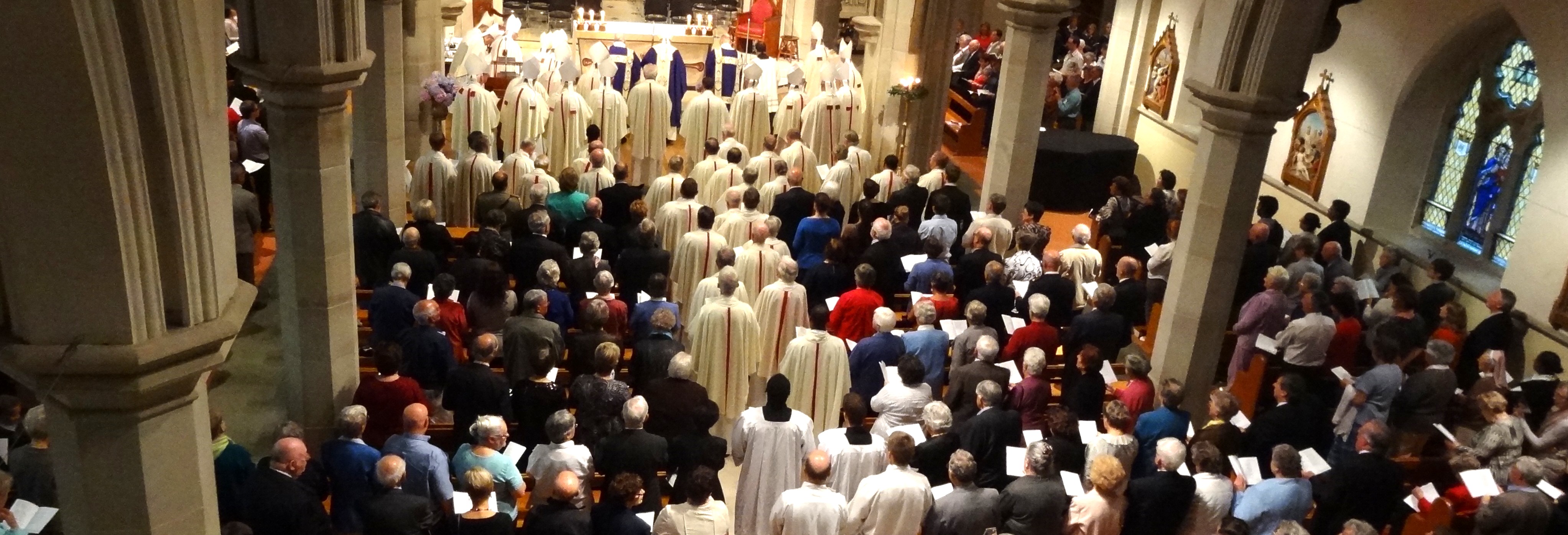What is Liturgy? Who Celebrates and Why?
National Liturgical Council

What is liturgy?
The word 'liturgy' originally meant a 'public work' or a 'service in the name of/on behalf of the people'. In Christian tradition it means the participation of the people of God in the 'work of God'. Through the liturgy Christ, our redeemer and high priest, continues the work of our redemption in, with, and through his Church (CCC 1069).
The word 'liturgy' derives from a Greek word: leitourgeia. It is the public, ritual way in which the Christian community enters into its relationship with God and nourishes, expresses, and develops its identity in, with and through Christ. Liturgy is the most sacred action in which we can engage since it unites us intimately with the mystery of Christ in God through the power of the Holy Spirit working and present in the worshipping assembly
Why do we celebrate?
The Church celebrates in the liturgy above all the Paschal mystery by which Christ accomplished the work of our salvation. It is this mystery of Christ that the Church proclaims and celebrates in her liturgy so that the faithful may live from it and bear witness to it in the world (CCC 1067, 1068).
Through its ritual celebration the Christian community continues to retell and remember its founding story, the paschal mystery of Christ. This is done through engaging together in public prayer which always includes listening to the sacred history as told in the scriptures, the Bible, as well as through symbolic action. Celebrating in this way brings the paschal mystery into the present and thus unites the whole Church with Christ and the members with one another and always leads to a renewed daily living of the mission of Christ.
Called through Baptism
The celebrating assembly is the community of the baptised who, by regeneration and the anointing of the Holy Spirit, are consecrated to be a spiritual house and a holy priesthood, that they may offer spiritual sacrifices. This common priesthood is that of Christ the sole priest, in which all his members participate (CCC 1141).
Through Baptism the person is welcomed into the Christian community (RBC 41), immersed into Christ's death in the waters and emerges 'christened', anointed by the Holy Spirit. The assent which is proudly professed by the assembly after the response to the Baptismal promises proclaims: 'This is our faith. This is the faith of the Church'. This profession indicates that the newly-baptised member's relationship with God is also one with the Church.
The rituals which complete the Rite of Baptism celebrate that this person is now clothed in Christ, anointed into the priestly, prophetic and kingly character of Christ, and called to keep the paschal light of Christ burning throughout life. This conversion into Christ makes one a member of the body of Christ, the Church built of living stones. From our Baptism we are always members of this body, always in communion with Christ and with our brothers and sisters. Therefore we can pray 'Our Father' with one another. In a sense, one is never alone after this initiation. Therefore the language of liturgy is usually plural: we, us, our.
The celebration of the Eucharist is the action of Christ and of the Church, namely, of the holy people united and ordered under the Bishop. It therefore pertains to the whole Body of the Church, manifests it, and has its effect upon it. Indeed, it also affects the individual members of the Church in a different way, according to their different orders, functions,, and actual participation. In this way, the Christian people, 'a chosen race, a royal priesthood, a holy nation, a people for his own possession', expresses its cohesion and its hierarchical ordering. All, therefore, whether ordained ministers or lay Christian faithful, in fulfilling their function or their duty, should carry out solely but totally that which pertains to them (GIRM 91).
While we are called to join together in exercising our common priesthood in Christ there is a distinction in the way this is exercised in the liturgy. There is a hierarchy of ministry and function which all derive from the common priesthood. Some members are ordained to the priestly ministry as bishop, priest or deacon. Only an ordained minister presides over the liturgical action by right of ordination. All other members of the Body of Christ have their own function. Each, in their own way, contributes to the celebration in which there are no onlookers. While some have a particular function, for example, as a reader or leader of song, the very fact of taking part through being there praying, responding, silently reflecting, singing, processing, standing, sitting is active participation. All are called to participate with intention and attention to the sacred mysteries.
Who is celebrating?
It is the whole community, the Body of Christ united with its Head that celebrates. Liturgical services are not private functions but are celebrations of the Church which is the sacrament of unity, namely, the holy people united and organised under the authority of the bishops (CCC 1140).
All liturgy has ramifications for the whole body of Christ since our worship is in unity with Christ and thus with the entire Church. One can never speak of 'my Mass' or 'my school liturgy' since all is part of the whole Church. Thus the liturgy reflects and brings about the unity of the Church.
The bishops of the Church work together to agree on changes to the liturgy. Each national or regional body of bishops may agree on defined issues affecting liturgical celebration in their area. Each diocesan bishop has authority in matters pertaining to his diocese. The local bishop is the chief shepherd and teacher in the diocese and thus is responsible for the overseeing of the liturgy. Many dioceses have established Liturgy Commissions or offices of worship to assist and advise the bishop in his role.
